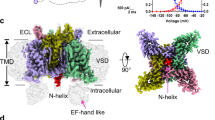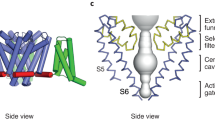Abstract
Tetrodotoxin (TTX) and saxitoxin (STX) are extremely potent poisons that prevent nerve and muscle cells from producing action potentials by blocking sodium channels1,2. If the channels are modified by reagents that act on carboxyl groups, however, both the binding of these toxins3,4 and their effect on the action potential5 are reduced. One such reagent, trimethyloxonium ion (TMO) converts channels into a form that is not blocked by TTX concentrations 105 times greater than its normal Kd (ref. 6). Most such chemical modifications of sodium channels also reduce the measured membrane sodium current, but it has not been known whether such reductions were due to a change in the number of channels, in permeability properties, or in gating properties. We now report that TMO-modified, TTX-resistant sodium channels have a smaller single-channel conductance (γ) with a more linear instantaneous current–voltage relationship than that of normal channels, and that the measured reduction in γ accounts for all of the decrease in sodium current after TMO treatment. This change in sodium channel permeability properties can be explained by the removal of a fixed negative charge near the outside of the channel.
This is a preview of subscription content, access via your institution
Access options
Subscribe to this journal
Receive 51 print issues and online access
$199.00 per year
only $3.90 per issue
Buy this article
- Purchase on Springer Link
- Instant access to full article PDF
Prices may be subject to local taxes which are calculated during checkout
Similar content being viewed by others
References
Kao, C. Y. Pharmac. Rev. 18, 997–1049 (1966).
Ritchie, J. M. & Rogart, R. B. Rev. physiol biochem. Pharmac. 79, 1–50 (1977).
Shrager, P. & Profera, C. Biochim biophys. Acta 318, 141–146 (1973).
Reed, J. K. & Raftery, M. A. Biochemistry 15, 944–953 (1976).
Baker, P. F. & Rubinson, K. A. Nature 257, 412–414 (1975); J. Physiol., Lond. 266, 3P–4P (1977).
Spalding, B. C. J. Physiol., Lond. (in the press); thesis, Univ. Washington, Seattle, University Microfilms International No. 7917640 (1978).
Dodge, F. A. & Frankenhaeuser, B. J. Physiol., Lond. 143, 76–90 (1958).
Sigworth, F. J. Nature 270, 265–267 (1977); J. Physiol., Lond. (in the press).
Hille, B. J. gen. Physiol. 50, 1287–1302 (1967).
Koppenhöfer, E. PflügersArch. ges. Physiol. 293, 34–55 (1967).
Hodgkin, A. L. & Huxley, A. F. J. Physiol., Lond. 116, 473–496 (1952).
Appel, H.-J., Bamberg, E., Alpes, H. & Läuger, P. J. Membrane Biol. 31, 171–188 (1977).
Conti, F., Hille, B., Neumcke, B., Nonner, W. & Stämpfli, R. J. Physiol., Lond. 262, 699–727; 729–742 (1976).
Author information
Authors and Affiliations
Rights and permissions
About this article
Cite this article
Sigworth, F., Spalding, B. Chemical modification reduces the conductance of sodium channels in nerve. Nature 283, 293–295 (1980). https://doi.org/10.1038/283293a0
Received:
Accepted:
Issue Date:
DOI: https://doi.org/10.1038/283293a0
This article is cited by
-
Single-channel analysis of two types of Na+currents in rat dorsal root ganglia
Pfl�gers Archiv European Journal of Physiology (1995)
-
Tetrodotoxin-resistant sodium channels
Cellular and Molecular Neurobiology (1994)
-
G-protein modulation of ion permeation through N-type calcium channels
Nature (1993)
-
Single-channel current/voltage relationships of two kinds of Na+ channel in vertebrate sensory neurons
Pfl�gers Archiv European Journal of Physiology (1993)
-
Excess divalent cations activate Ca2+-mobilizing receptors in pancreatic acinar cells
Pfl�gers Archiv European Journal of Physiology (1993)
Comments
By submitting a comment you agree to abide by our Terms and Community Guidelines. If you find something abusive or that does not comply with our terms or guidelines please flag it as inappropriate.



